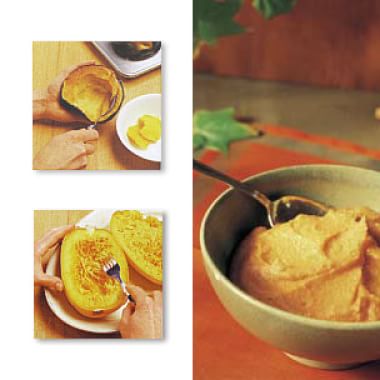
The firm flesh of hard winter squashes becomes tender and sweet when cooked. It can then be easily scooped out or, with spaghetti squash, removed in long, thin strands.
1. Spaghetti squashes should be roasted whole. For other winter squashvarieties, using a large, sharp knife, carefully cut the squash in half lengthwise through its stem and flower ends. If the skin is very hard, use a kitchen mallet to tap the knife gently once it is securely wedged in the squash.
2. Place the whole spaghetti squash, or the squash halves cut side down, in a baking dish and add water to a depth of 1 inch. Bake at 350°F until the squash is tender when pierced, 30 minutes to 1 1/4 hours, depending on the variety. Add more water to the dish if it evaporates.
3. For varieties other than spaghetti squash: Let the squash cool. Using a spoon, scoop outthe seeds and fibers and discard. Then spoon out the tender flesh.
4. For spaghetti squash: Let the squash cool, then cut in half and scoop out and discard the seeds. Using a fork, gently scrape out the flesh, which will separate into spaghetti-like strands.
1. Spaghetti squashes should be roasted whole. For other winter squashvarieties, using a large, sharp knife, carefully cut the squash in half lengthwise through its stem and flower ends. If the skin is very hard, use a kitchen mallet to tap the knife gently once it is securely wedged in the squash.
2. Place the whole spaghetti squash, or the squash halves cut side down, in a baking dish and add water to a depth of 1 inch. Bake at 350°F until the squash is tender when pierced, 30 minutes to 1 1/4 hours, depending on the variety. Add more water to the dish if it evaporates.
3. For varieties other than spaghetti squash: Let the squash cool. Using a spoon, scoop outthe seeds and fibers and discard. Then spoon out the tender flesh.
4. For spaghetti squash: Let the squash cool, then cut in half and scoop out and discard the seeds. Using a fork, gently scrape out the flesh, which will separate into spaghetti-like strands.









